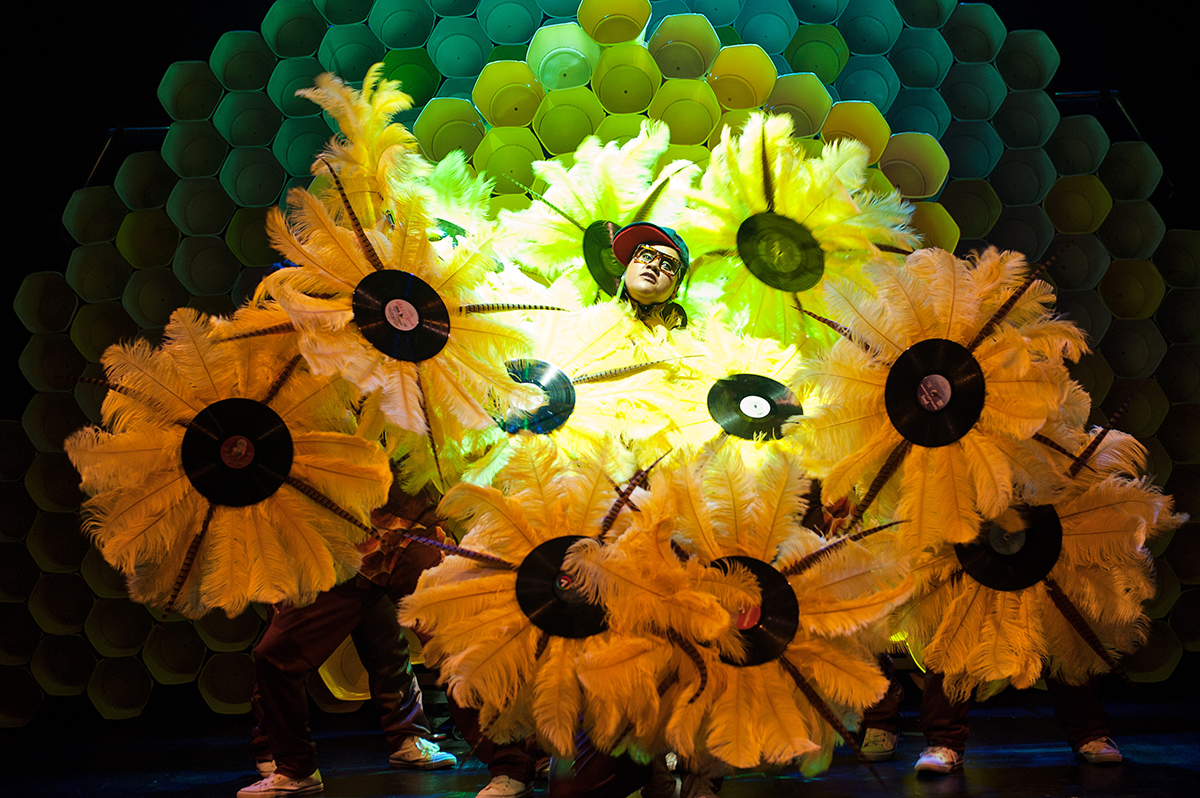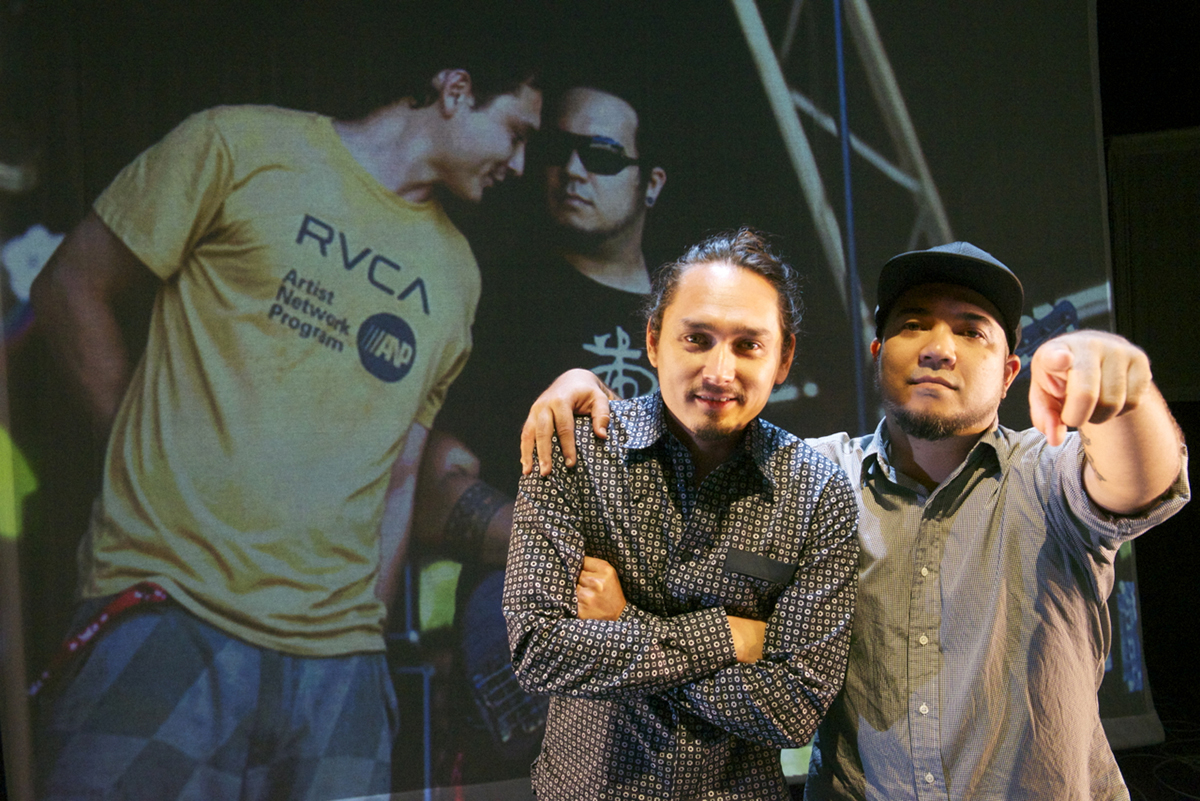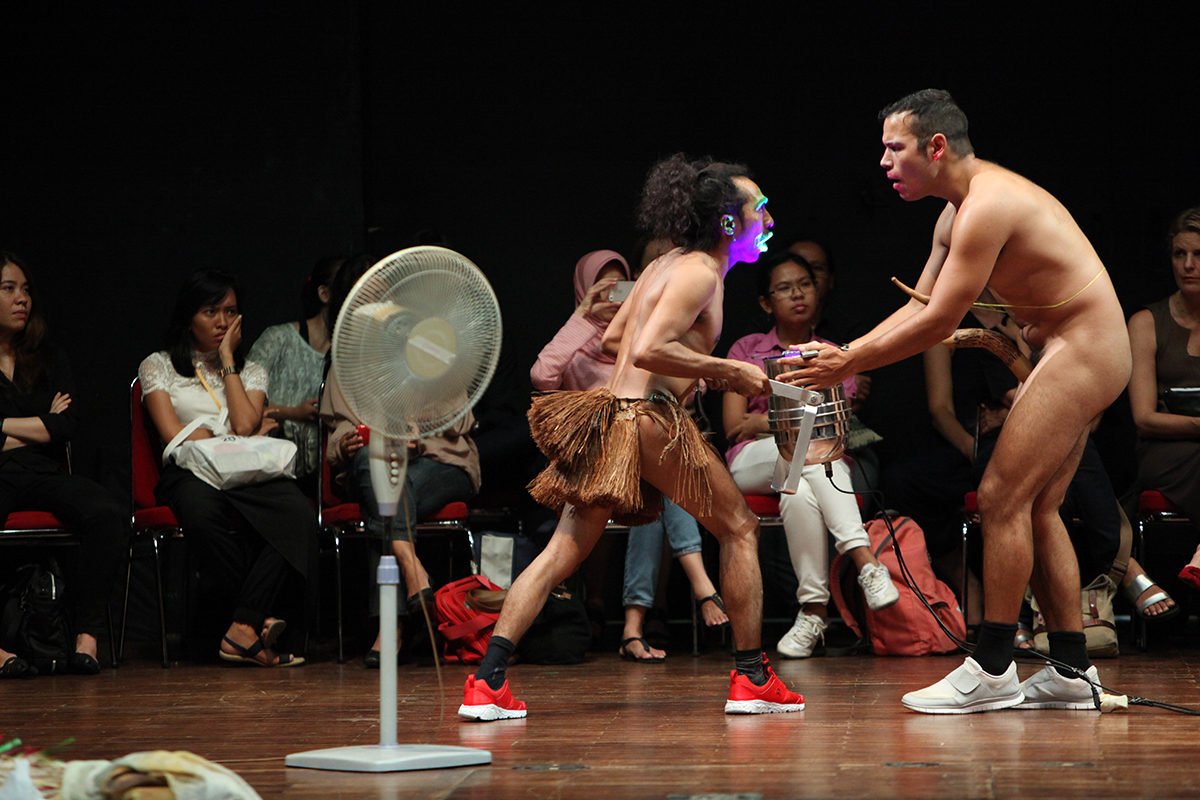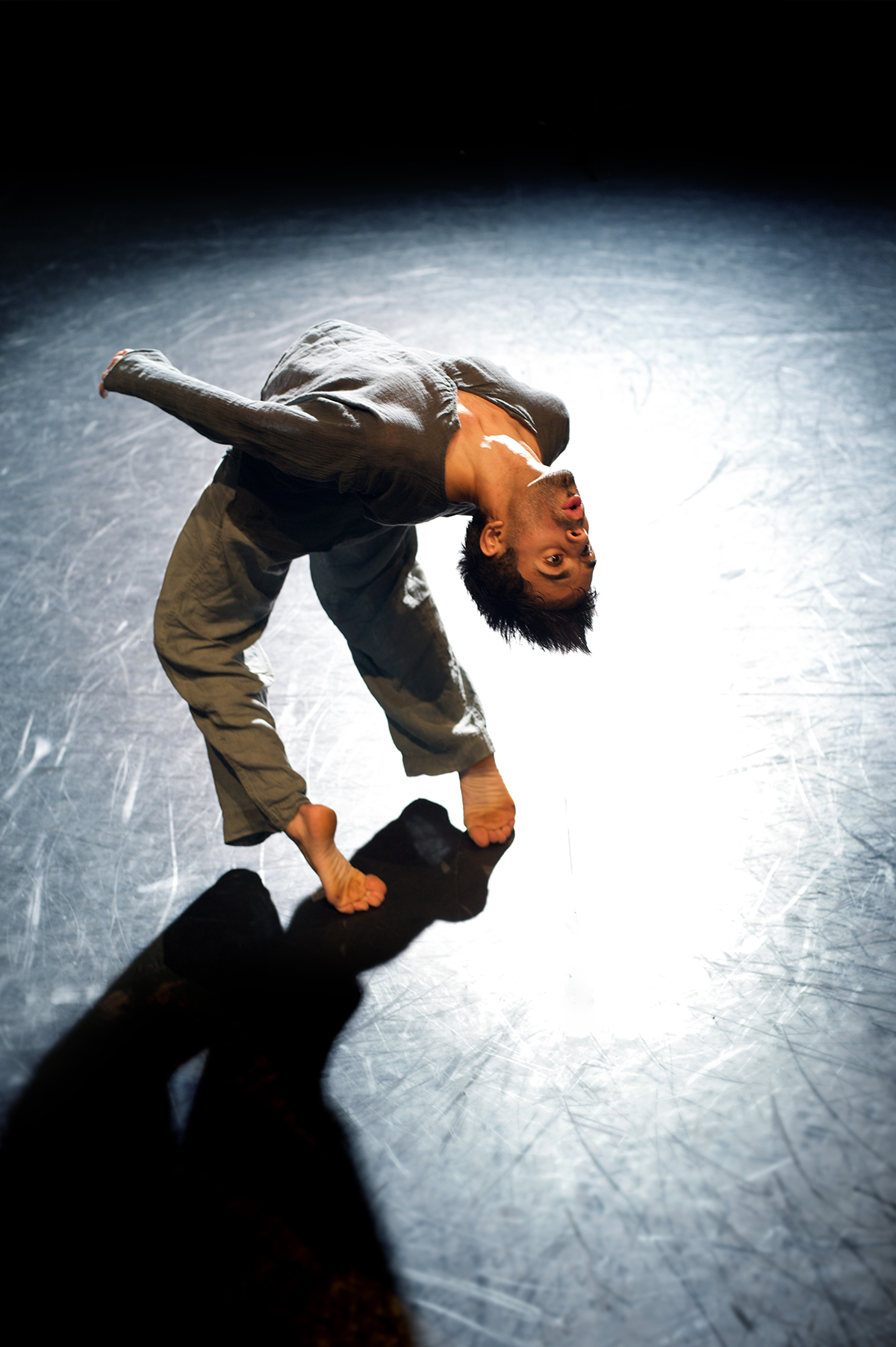
OzAsia Festival: The cultural deep-end
In the second of his reviews of OzAsia performances, Ben Brooker embraces works by Hot Brown Honey, Joelistics and James Mangohig, Darlane Littay and Tian Rotteveel, and Aakash Odedra, their performances revealing the complexities of cultural heritage and exchange.
Hot Brown Honey
“Moisturise and decolonise” is the catch cry of Hot Brown Honey’s MC Busty Beatz (Kim Bowers), who presides, resplendent in oversized afro, over Black Honey Company’s ensemble of “black, brown and mixed beauties” – six female performers of Indigenous Australian, South African, Maori, Tongan and Samoan heritage. The work, which has toured extensively since 2015, defies categorisation. Intensely politically charged, it is burlesque-like in its parodic treatment of popular forms, especially those reliant on racist stereotyping, but hews closer to the Victorian era idea of burlesque as extravaganza. Routines draw on circus, cabaret, stand-up comedy and striptease.
The aesthetic is similarly mixed, heavily inflected by vintage hip-hop but spruced up with designer Lisa Fa’alafi’s glittering costumes, their multiple layers frequently cast off in ways that suggest the performers’ disavowal of imposed identities. The stage is bare except for “the hive,” a honeycombed, open-sided gallery — designed by Tristan Shelley and vibrantly lit by Paul Lim in a way that synchronises with much of the action — that serves as Busty Beatz’ base. From here she musically directs the work, marshalling the performers around her own compositions and delivering short, sharp sermons on feminist theory, quoting, among others, Chimamanda Ngozi Adichie: “The single story creates stereotypes, and the problem with stereotypes is not that they are untrue, but that they are incomplete. They make one story become the only story.”
Hot Brown Honey is an unapologetically didactic, rallying work. Sequences touch on and subvert the longstanding typecasting of women of colour as maids, the casual racism of white Australians on holiday and stereotypes of the dusky maiden/noble savage variety that have long been the source of sexualised European fantasies. Some scenes are more abstruse, such as those including Ofa Fotu’s scorching torch song-like reclamation of James Brown’s “It’s a Man’s Man’s Man’s World,” and Crystal Stacey’s aerial routine that serves as a powerful metaphor for intimate partner violence. Underlying all of this is a discourse — sometimes edgily evoked, as in a scene in which Torres Strait Island performer Ghenoa Gela pointedly casts off the Australian flag —on the rights of indigenous peoples in a post-colonial world. While the tonight’s predominately white audience is implicated in the intersecting oppressions exposed, the atmosphere remains unifying and celebratory. Everybody is clapping and dancing by the end, some spilling onto the stage to mingle with the performers as the last of Busty’s pounding, soulful grooves reverberate around the theatre.

Joelistics, James Mangohig, In Between Two, Contemporary Asian Australian Performance, photo William Yang
In Between Two
In Between Two, a collaboration between Asian-Australian musicians Joelistics (Joel Ma) and James Mangohig, also recuperates the political charge of early and alternative hip-hop. In the opening song, Ma raps about what the form means, or rather doesn’t mean, to him: misogyny, homophobia. His political awakening was concomitant with the rise of Pauline Hanson and her infamous warning that “we are in danger of being swamped by Asians.” Ma informs us he and Mangohig — both ‘mixed race’ with Asian fathers and white mothers — have been long-term friends since meeting under a tree in Darwin during a music festival. There, they bonded over their shared status as outsiders in a majority white music industry and their worship of Brisbane band Regurgitator, led by Asian-Australian multi-instrumentalist Quan Yeomans.
Produced by Contemporary Asian Australian Performance, In Between Two is the latest iteration of a performance model developed by theatre-makers William Yang and Annette Shun Wah. Here, as in The Backstories, which premiered at this year’s Adelaide Festival, Yang and Shun Wah provide dramaturgy with Suzanne Chaundy directing. The setup is simple and effective: against visual designer Jean Poole’s backdrop of sensitively curated archival photos and videos the performers share stories from their lives and family histories in a series of direct address monologues. The stories are interspersed with songs that utilise both live and recorded instrumentation, Mangohig occasionally taking up his bass guitar, Ma rapping and playing a variety of instruments including keyboards and samplers. As performers, Mangohig and Ma have an abundance of chemistry and charisma. “Each of us,” Ma muses, “is a vast archive of our family stories.”
And what stories they are. Ma’s grandparents — the beautiful, Australian-born Edith and the handsome Charlie from Hong Kong, who chose her from a photograph to be his bride when she was just 17 — were well-known identities in Sydney’s Chinatown. Charlie ran a fruit and vegetable business. In the 1960s, Edith was a partner in the glamorous Chequers nightclub, mingling with the top entertainers of the day (in one photograph she poses with Bob Hope) as well as assorted gangsters. Ma’s parents were bohemians, setting up for a time in a London squat before returning to Australia and separating by the time Ma was two (“I grew up between two households,” he says).
Mangohig’s story contrasts sharply. His father was a preacher from rural Philippines, his mother the daughter of conservative Dutch migrants. Pen pals at first, the two eventually overcame parental objections to their marriage and settled in Darwin. Mangohig was a “pastor’s kid,” playing in a Christian rock band and seemingly headed for the ministry until experiencing a crisis of faith. He marries and divorces, earning the wrath of his father and his church. Ma, too, has a dark night of the soul, his dislocated adolescence resulting in truancy and drug abuse, a collapse of purpose. Both are troubled by racism and alienation, and locate music as a potential site of redemption. “So what was mine to embrace?” asks Ma rhetorically. “Music.”
For Ma, the arrangement and telling of these stories is in itself a kind of sampling, wherein “little nuggets of gold” are unearthed to construct new ways of knowing. “We are [our family’s] wildest dreams and their most elaborate remixes,” he says. In their careful crafting of these dreams and remixes, Ma and Mangohig, and their skilful collaborators, provide fresh insights into the nature of multicultural identity, and the power of meaning-making — whether through music or theatre — to suture and transcend.

Darlane Litaay, Tian Rotteveel, Specific Places Need Specific Dances, photo Tian Rotteveel
Specific Places Need Specific Dances
In Specific Places Need Specific Dances, Papua-born, Indonesia-based dancer Darlane Littay and Netherlands-born, Berlin-based composer and choreographer Tian Rotteveel take as their starting point the idea of waiting — for inspiration to strike or, more prosaically, simply for something, anything, to happen.
It’s an idea embedded in the form of the work, which is structurally loose, and presumably largely improvised (I say presumably because, though the work often feels extemporary, videos available via Google show marked similarities between this and earlier productions).
Littay and Rotteveel chat with each other, sometimes inaudibly, both in English and their native languages. They wander around the space in everyday clothes, show us a little bit of what looks like rehearsal footage on a TV monitor they wheel on and off. Eventually Littay picks up his mobile phone and inserts it into a cardboard cup for amplification. He plays snatches of music. Some of it sounds like it might be Papuan — traditional, ethereal —some of it Western, beat-driven. Rotteveel moves a little to it; nothing too defined. He sways, fans his arms out slowly. Mostly I think he is just listening.
The roles are reversed to no particular effect, Rotteveel eventually finding his way to a mixer attached to a subwoofer on castors. He pushes it around the space, manipulating a sonic pulse that becomes steadily louder until we can feel it in our bodies. Rotteveel wields a shaker in time with the pulse. Both he and Littay vocalise synchronously with it, sometimes grunting, sometimes seemingly issuing short injunctions to each other. They undress fully, and individually don koteka, elaborately decorated penis sheaths of Papuan origin. Also applying luridly-coloured face paint, the two dancers become strikingly ‘other,’ a process complicated by the cultural reciprocity – or is it appropriation? — underway. We may speculate that Littay has given Rotteveel permission to enter into this highly specific tradition, that he is even suitably placed to do so, but we can’t be sure.
Littay and Rotteveel continue their meandering explorations of the space, and each other’s practices, replacing all of the theatre’s lighting gels with red ones, holding a sheet of plastic over the subwoofer to create a startling buzz saw-like effect, and making each other dance to Empire of the Sun’s “Walking on a Dream.” Finally, Rotteveel reads from a long, rambling letter detailing the daily rituals — most of them a kind of waiting or delaying — that surrounded the duo’s working together. It’s a fittingly offbeat conclusion to a work that, despite its title, engages less with the idea of site specificity in performance than with the complexities, both banal and unexpected, of creative process and cultural exchange.

Aakash Odedra, Rising, Photo Chris Nash
Rising
The work of British-Bangladeshi choreographer Akram Khan bookended this year’s OzAsia Festival, which opened with Khan’s momentous Until the Lions and concluded with British dancer Aakash Odedra’s suite of four solo works, Rising, featuring Khan’s In the Shadow of Man.
The first solo is choreographed by Odedra himself, and takes its names from nritta, a ‘pure’ version of the classical Indian form Kathak that emphasises footwork, gestures and turns, all gradually increasing in speed and energy. Barefoot and dressed in traditional dhoti and loose-fitting trousers, Odedra uses the full depth and breadth of the Playhouse stage to execute a mesmerising series of pirouettes, turns and leaps accompanied by a soundtrack of tabla and drone in traditional 16-beat time. He spins on his knees, so rapidly that the eyes can’t keep up and his whole body blurs, in a partial deconstruction of Kathak’s characteristic verticality. Elsewhere the solo is more traditional, Odedra’s face retaining Kathak’s expressiveness, and sharp turns of his head indicating shifts in speed and motion.
In Khan’s In the Shadow of Man, atmospherically lit by Michael Hull, Odedra is transmuted into a monstrous figure. He crouches in the near-dark, emitting an animalistic howl, bare-chested with his back to us, his shoulder blades flexing grotesquely. As Jocelyn Pook’s ominous electro-acoustic sonic landscape builds, Odedra starts to move, arms bent back behind his body, reminiscent of a newborn animal learning to walk, conscious and frightened of its vulnerability. In a move that will be replicated in the following piece, Odedra — supremely confident and supple — extends backwards onto his hands, his face leering horribly at us from floor level.
In the third solo, Russell Maliphant’s Cut, Hull’s lighting is used to create columns, walls and washes of sometimes diffuse, sometimes tightly focused white light that Odedra manipulates — casting shadows that create the illusion that his hands are growing in size, or that sand is running through them — in a choreography that is fluid, controlled and deeply sensuous. In a repeated gesture, something like cradling or praying, and sonic and choreographic references to the movement of clock hands, I detected themes of entropy and the inexorability of time.
The final piece, Constellation, choreographed by Sidi Larbi Cherkaoui and lit by Willy Cessa, brings the evening, and the OzAsia Festival, to a reflective, quietly transporting close. Fifteen light globes hang above the stage at different levels. Odedra moves slowly, gracefully among them, activating each in turn with his touch, and setting them in motion with gentle pushes that have unpredictable results. Sometimes the lights merely bob up and down, gradually expending their kinetic energy, and sometimes they careen erratically through the space, narrowly avoiding each other and Odedra. Olga Wojciechowska’s cascading, reverberant score for piano adds to a sense of the numinous, of a cosmos in perpetual flux, moving out of darkness, into light, and finally — as Odedra floats and whirls among the lights, extinguishing each one — returning to its germinal, pre-time state.
–
OzAsia Festival: Black Honey Company, Hot Brown Honey, creator, musical director, composer, sound designer Busty Beatz, creator, director, choreographer, designer Lisa Fa’alafi, lighting designer Paul Lim, set designer Tristan Shelley, Space Theatre, 26-30 Sept; Contemporary Asian Australian Performance, In Between Two, writers, composers, performers Joel Ma, James Mangohig, director Suzanne Chaundy, visual designer Jean Poole, Space Theatre, 5-6 Oct; Darlane Litaay and Tian Rotteveel, Specific Places Need Specific Dances, choreographers, dancers Darlane Litaay, Tian Rotteveel, Nexus Arts, 27-28 Sept; Aakash Odedra, Rising, Dunstan Playhouse, Adelaide, 6-7 Oct
Top image credit: Busty Beatz, Hot Brown Honey, Briefs Factory, photo courtesy OzAsia






